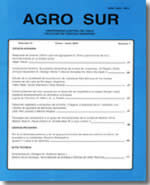EFFICACY OF BENOMYL+CAPTAN AND BC1000 IN THE CONTROL OF BOTRYTIS CINEREA AND ALTERNARIA ALTERNATA IN HIGHBUSH BLUEBERRY (VACCINUM CORYMBOSUM) CV. BLUEJAY
Main Article Content
Abstract
It was determined the phenological stage of higher susceptibility, incidence and control of Botrytis cinerea and Alternaria alternata in three year old plants of highbush Blueberry cv. Blejay. The fungicides benomyl+captan (45g+144g i.a/HL) and BC1000 (150 c.c. i.a./HL) were evaluated. The treatments consisted of 1, 2, 3 and 4 aplications of BC1000 between the beginniug of flowering and maturity; and a comparative experiment between benomyl+captan and BC1000 with 1, 2, 3 aplications in differents phenological stage between full flowering and maturity. The fruits were mantained in a cold chamber (0°; 95% H.R) for a period of 14 days and in laboratory conditions (average of 18°; 60% H.R), for 7 days. The incidence of fungi was evaluated to the harvested crop and until the end of the storage period. Phenological stages of more susceptibiliíy to B.cinerea were flower-clot and maturity, while no such stages were accurately established for A.alternata. BC1000 had a more effcctive control over B.cinerea aplicated in flower-clot and maturity, while flowering aplications were no effective. BC1000 in field conditions did not control A.alternata significatively. Benomyl+captan was more effective than BC1000 over B.cinerea with three aplications from full flowering to maturity, and there were no differences between fungicides with two aplications (flower-clot and maturity) and one in maturity.

